News

20242023202220212020
Flavored Oral Nicotine Pouches as Chewing Gums – Interview by Irfan Rahman, PhD
Monday, November 27, 2023
ZYN Pouches Are Gaining Popularity—How Do They Compare to Smoking and Vaping?
ZYN pouches are growing in popularity, and it could be a problem.
There are multiple brands of nicotine pouches, but ZYN has recently exploded on platforms like TikTok, with videos on the topic garnering 292.6 million views.
Nicotine pouches are purportedly intended to help people stop smoking cigarettes, Irfan Rahman, PhD, who runs a lab that conducts research on toxicants at the University of Rochester Medicine, told Health.
But the products have not been sufficiently studied, and it’s impossible to say whether or not they actually help with smoking cessation.
“There’s no data available,” Rahman said. “If somebody’s saying that, they’re making up data.”
Read More: Flavored Oral Nicotine Pouches as Chewing Gums – Interview by Irfan Rahman, PhDDeborah Cory-Slechta: Research Pointing to Herbicide and Parkinson’s Association is 'Overwhelming'
Wednesday, November 22, 2023
The professor of Environmental Health Sciences appeared on ABC News’ Nightline to discuss the growing scientific evidence linking the widely used herbicide paraquat to Parkinson’s disease and efforts to undermine concerns about the chemical’s health risks (Part 1, Part 2). Read about how URMC researchers are leading efforts to understand how environmental exposure to chemicals is driving a rise in rates of Parkinson’s, making it the world’s fastest growing neurological disease.
Study: Marijuana Users Found to Have Higher Levels of Toxic Metals In Blood and Urine
Friday, September 15, 2023
Marijuana smokers may unknowingly be consuming heavy metals, a new study shows.
Heavy metals accumulate in the body and have been linked to a host of health issues including cancer, cognitive impairment, and heart disease.
And, people consuming marijuana may be more at risk of these toxins entering their bloodstream.
Irfan Rahman, PhD, director of Flavor Inhalation Toxicology Research at the University of Rochester Medical Center told Health that while the gut contains enzymes that can help the body get rid of heavy metals (particularly lead), the lungs don’t have the same system in place.
This means inhaling marijuana, by smoking or vaping, may be more damaging than taking an edible.
On top of this, the logistics of vaping could add another aspect of heavy metal exposure for marijuana users.
The reduction process that extracts cannabidiol from the cannabis plant can introduce heavy metals and other contaminants, including solvents used to extract essential oils from the flower, Rahman explained.
If done incorrectly, these lab-made marijuana extracts have a higher chance of releasing metals when they hit the hot coils of a vape pen, he said.
Read More: Study: Marijuana Users Found to Have Higher Levels of Toxic Metals In Blood and UrineWhat Makes Us Tick: Smoking’s Effect on Our Biological Clock
Thursday, August 10, 2023
Cells in nearly every human tissue and organ contain proteins that govern circadian rhythms. In essence, these molecules together act as a microscopic clock timed to waxing and waning sunlight.
“When sunlight enters your eyes in the morning, it sends a signal to the pineal gland in your brain that sets off a chain reaction of hormone production, waking your body up and affecting your appetite, body temperature, blood pressure, and more,” Rahman explained. “As darkness sets in, your body winds down, preparing for sleep.”
Rahman studies how environmental exposures affect molecular clock proteins in the lungs.
“The molecular clock’s purpose is to prepare your body for expected changes in the environment, like the times for activity, times for sleep, and times to eat,” Rahman said. “However, environmental exposures, including tobacco smoke and vaping, can disrupt the production of clock molecules, leading not only to changes in sleep cycles but also to lung injury or respiratory disease.”
For example, in a study on the effects of trendy e-cigarette and tobacco products on lung health, Rahman and team found that exposure to either waterpipe smoke or e-cigarette vapor altered expression of molecular clock proteins in mouse lungs. Those changes could in turn affect lung function, the authors suggested.
Jet lag, night-shift work, and blue light from electronic devices can also affect the molecular clock. Smoking or vaping can potentially exacerbate the impacts of those factors.
Read More: What Makes Us Tick: Smoking’s Effect on Our Biological ClockDebra Cory-Slechta Explains How Wildfire Smoke and Air Pollution can Harm the Brain
Thursday, August 3, 2023
In an interview with Rick Woychik, director of the National Institute of Environmental Health Sciences, the professor of Environmental Medicine shares how research into how fine air particles impact the brain is transforming our understanding of neurodegenerative and neurodevelopmental disorders. Woychik interviewed Cory-Slechta after seeing her presentation at the first Human Health and the Environment Research Symposium at the Medical Center in June, where he was a guest speaker.
Read More: Debra Cory-Slechta Explains How Wildfire Smoke and Air Pollution can Harm the BrainDr. Rahman appears in Men's Health Magazine GQ
Thursday, June 22, 2023
Why Are Zyn Nicotine Pouches Suddenly Everywhere?
Zyn nicotine pouches have recently been spotted with Major League baseball players skirting tobacco bans, on the Joe Rogan Experience, and behind the lip of Tucker Carlson, who recently gave what sounded like an infomercial on the Full Send podcast, calling the pouches a “massive life-enhancer” that he uses around the clock. In New York City, it’s now possible to walk into a bodega, buy a can of Zyn, step outside, and throw it and hit another store that sells the brand.
Unlike cigarettes or vapes, these pouches are discreet, typically tucked in the upper lip. Unlike chewing tobacco and traditional pouches, they don’t require spitting any brown goo—they’re made with a white synthetic nicotine powder instead of ground tobacco leaves. And it turns out that pouches filled with a highly addictive drug—nicotine—sell really well. Usage has doubled annually since 2019, and overall sales exceeded 800 million units in the first three months of 2022, according to research published by the American Cancer Society.
There are lots of brands of pouches on the market, including Rogue, On!, and Velo. If you find the fratty aura of the stuff off-putting, you might prefer the colorfully packaged Lucy pouches, billed as “nicotine for normal people,” and sold by a company co-founded by Soylent co-founder David Renteln. But it’s Zyn that has emerged as the “Kleenex” of pouches—it has by far the largest share of overall sales of the product. Last year, tobacco giant Phillip Morris International acquired Zyn's parent company, Swedish Match, in a $16 billion transaction.
 Irfan Rahman, a professor and researcher at the University of Rochester Medical Center, pointed out that oral tobacco in several forms has been popular in India far before Zyn was conceived. Rahman runs a lab focused on environmental toxicants like cigarettes, and has co-authored multiple papers on nicotine pouches.
Irfan Rahman, a professor and researcher at the University of Rochester Medical Center, pointed out that oral tobacco in several forms has been popular in India far before Zyn was conceived. Rahman runs a lab focused on environmental toxicants like cigarettes, and has co-authored multiple papers on nicotine pouches.
Rahman’s interest in oral nicotine products is personal. He recalls catching stray tobacco spit on his shirt in a movie theater as a kid in India. He also remembers taking long-distance flights to the US and UK while passengers freely lit up in the cabin.
Read More: Dr. Rahman appears in Men's Health Magazine GQTobacco and Menthol Flavored E-Cigarettes Cause Lung Damage, Inflammation, and Dampened Immunity
Monday, May 1, 2023
Tobacco and menthol flavors are available for almost all tobacco products, including electronic cigarettes (e-cigs). A study by the University of Rochester (published in Toxicological Sciences on Apr 13, 2023; https://doi.org/10.1093/toxsci/kfad033) found that tobacco and menthol flavors used in e-cigarettes cause lung damage and immune suppression. The study found flavored e-cigs contain unique composition flavoring chemicals (e.g., ethyl maltol and vanillin in tobacco flavored e-cigs) and (e.g., terpenes and levomenthol) in menthol flavored e-cigs to impart a unique, enticing aroma. However, there are numerous overlapping chemicals in various amounts in both flavors at various concentrations across brands, despite the FDA regulatory ban on flavored tobacco products. The study emphasized the need for hazard characterization of flavoring chemicals and additives in e-cigs instead of generalizing a specific flavor or flavors as toxic.
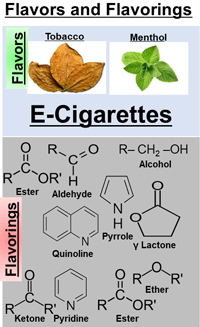 The study tested two popular brands of e-cigs of tobacco and menthol flavors by exposing naïve mice for just three days, simulating an exposure of never smokers to a short e-cig use. The study demonstrated genotoxicity and immunomodulatory effects driven by metabolic dysregulation in lung cells. Menthol-flavored e-cigs caused immunosuppression, while tobacco-flavored e-cigs were associated with immunosuppressive and allergic responses, suggesting weakened immunity and host defense. Apart from flavoring chemicals, secondary products, such as ethanol and acrolein present in these may be associated with genotoxicity and lung injury. The study also found the toxicological effects of the same flavor by various brands and the need to establish standardized toxicological parameters and indices for appropriate premarket authorization for e-cigarette products. Dr. Thivanka Muthumalage, a Postdoctoral Fellow, and Dr. Irfan Rahman, a Professor of Environmental Medicine at the University of Rochester, stated that nicotine interaction with flavoring chemicals causes unique toxicological changes in the lung, the need to characterize e-cig aerosol “mixture” toxicity. The authors further stated that chemicals with antitussive properties and cooling effects are added to reduce the harshness of these products. Hence. the current market products include flavoring additives and enhancers (e.g., linalool, cinnamyl acetate, furanone, and other flora, fruity, and sweet chemicals) for smoother vaping and attracting new /young users to a gateway of vaping other products.
The study tested two popular brands of e-cigs of tobacco and menthol flavors by exposing naïve mice for just three days, simulating an exposure of never smokers to a short e-cig use. The study demonstrated genotoxicity and immunomodulatory effects driven by metabolic dysregulation in lung cells. Menthol-flavored e-cigs caused immunosuppression, while tobacco-flavored e-cigs were associated with immunosuppressive and allergic responses, suggesting weakened immunity and host defense. Apart from flavoring chemicals, secondary products, such as ethanol and acrolein present in these may be associated with genotoxicity and lung injury. The study also found the toxicological effects of the same flavor by various brands and the need to establish standardized toxicological parameters and indices for appropriate premarket authorization for e-cigarette products. Dr. Thivanka Muthumalage, a Postdoctoral Fellow, and Dr. Irfan Rahman, a Professor of Environmental Medicine at the University of Rochester, stated that nicotine interaction with flavoring chemicals causes unique toxicological changes in the lung, the need to characterize e-cig aerosol “mixture” toxicity. The authors further stated that chemicals with antitussive properties and cooling effects are added to reduce the harshness of these products. Hence. the current market products include flavoring additives and enhancers (e.g., linalool, cinnamyl acetate, furanone, and other flora, fruity, and sweet chemicals) for smoother vaping and attracting new /young users to a gateway of vaping other products.
This research is funded by the National Institutes of Health.
EHSC Member Publishes in National Academies
Friday, April 28, 2023
EHSC member Dr Ehsan Hoque and colleagues published a very compelling perspective by the National Academy of Engineering, highlighting connections among computer science, climate change, human health, and cognition. The article titled "The Untapped Potential of Computing and Cognition in Tackling Climate Change".
See below for link to article.
Read More: EHSC Member Publishes in National AcademiesHalting the Rise of Parkinson’s
Monday, April 24, 2023
Quality of life, health, and longevity are being increasingly tied to someone’s zip code rather than their genetic code. Cancer, heart disease, neurodegenerative disorders, and even our ability to fight infection are linked to the myriad of chemicals we are exposed to, often unwittingly, over the course of our lives. The University of Rochester’s leadership in the field of environmental medicine stretches back to toxicology research programs developed at the University under the Manhattan Project. These programs also served as the basis for the formation of a NIEHS Center of Excellence in environmental toxicology and health that is one of the oldest in the country celebrating 50 years of sustained funding. This foundation and the decades of work that followed—coupled with the recognition that the public health threat requires a collaborative commitment to research, education, and community engagement—led to the creation of the new Institute for Human Health and the Environment.
Paige Lawrence, PhD, the Wright Family Research Professor and chair of the Department of Environmental Medicine, is the founding director of the new Institute. “Genetics only explaining 10 to 15 percent of human health, which leaves the rest to the environment,” said Lawrence. “If we really want to have an impact on health, environmental influences need to be front and center.”
The new Institute will help power a team of neurologists, neuroscientists, toxicologists, epidemiologists, and researchers at the University of Rochester who are examining the impact of environmental chemical exposure on the brain. One disease in particular stands out. Parkinson’s is the fastest growing neurodegenerative disease in the world, outpacing even Alzheimer’s, and a growing number of scientists are linking the disease’s rise to air pollution, pesticides, and a ubiquitous chemical pollutant.
Up the nose it goes
Air pollution is associated with many health problems, including asthma, heart disease, stroke, low birth weight, and inflammation. While epidemiological studies have hinted at the link between air pollution and neurological disorders like Parkinson’s and Alzheimer’s, the route these chemicals use to make their way into the brain, and the damage caused once there, was until recently poorly understood.
“We’ve known that air pollution has effects on the heart and the lung for a very long time, but it's really only been in about the past ten years that attention has been directed to its effects on the brain,” said Debbie Cory-Slechta, PhD, a professor of Environmental Medicine, Neuroscience, and Public Health Sciences. Cory-Slechta’s colleagues at the University of Rochester, Guenter Oberdoerster, PhD, and Alison Elder, PhD, were among the first to show that ultra-fine air pollution particles, called PM0.1, are able to hitch a ride directly into the brain via the nasal passage and olfactory nerves, bypassing the brain’s normal defenses.
Read More: Halting the Rise of Parkinson’sScientific Breakthrough in Reversing Lung Aging and COPD: Removal of older cells reverts tobacco smoke-induced lung damage
Monday, April 24, 2023
A recent study by the University of Rochester published in Aging Cell (http://doi.org/10.1111/acel.13850) found that clearing of aged/senesced lung cells reversed lung damage and pathologies caused due to exposure to cigarette smoke and environmental pollutants. Environmental stressors cause lung damage and inflammation which are involved in the pathogenesis of lung diseases, such as Chronic Obstructive Pulmonary Disease (COPD) and Idiopathic Pulmonary Fibrosis (IPF). In this respect, premature aging or enhanced cellular senescence in the lung is 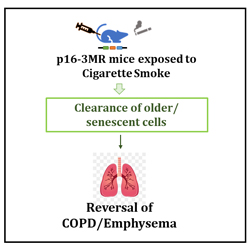 associated with disease development and progression in various lung pathologies. This raised an intriguing question to understand the role of lung cellular senescence in lung inflammation and tissue injury on exposure to active or passive cigarette smoke. To do this, researchers at the University of Rochester used a specialized rodent model system p16-3MR that allows the identification of ‘senesced’ (aging) cells through luminescence and/or fluorescence detection and allowed the selective elimination of ‘senesced’ cells using anti-viral drug ganciclovir. They found an overall increase in the lung cellular senescence in the animals exposed to cigarette smoke. These animals showed increased inflammation, immune cell infiltration and tissue injury that led to deterioration in the lung function parameters (signs of developing COPD/emphysema). Importantly, the researchers showed in this study that clearance of the tobacco smoke induced ‘senesced’ cells reversed the lung tissue damage. Lead investigator, Dr. Irfan Rahman, Professor and Dr. Gagandeep Kaur, Postdoctoral Fellow at the Department of Environmental Medicine state that, “This study has important implications in identifying pharmacological ways of removing older/senesced cells via newly developed senolytics to treat lung pathologies like COPD/emphysema, where the current therapies are mainly symptomatic.”
associated with disease development and progression in various lung pathologies. This raised an intriguing question to understand the role of lung cellular senescence in lung inflammation and tissue injury on exposure to active or passive cigarette smoke. To do this, researchers at the University of Rochester used a specialized rodent model system p16-3MR that allows the identification of ‘senesced’ (aging) cells through luminescence and/or fluorescence detection and allowed the selective elimination of ‘senesced’ cells using anti-viral drug ganciclovir. They found an overall increase in the lung cellular senescence in the animals exposed to cigarette smoke. These animals showed increased inflammation, immune cell infiltration and tissue injury that led to deterioration in the lung function parameters (signs of developing COPD/emphysema). Importantly, the researchers showed in this study that clearance of the tobacco smoke induced ‘senesced’ cells reversed the lung tissue damage. Lead investigator, Dr. Irfan Rahman, Professor and Dr. Gagandeep Kaur, Postdoctoral Fellow at the Department of Environmental Medicine state that, “This study has important implications in identifying pharmacological ways of removing older/senesced cells via newly developed senolytics to treat lung pathologies like COPD/emphysema, where the current therapies are mainly symptomatic.”
This research is funded by the NIH, an other author of the study includes Dr. Thivanka Muthumalage.
Uncovering How the Biological Clock Impacts Lung Health
Monday, April 17, 2023
Study reveals mechanism by which a circadian clock molecule leads to lung fibrosis
Abnormal sleep patterns, like those of night-shift workers, disrupt the body’s natural biological clock and have been linked to lung health issues. A new study by University of Rochester Medical Center (URMC) researchers shows how a biological clock molecule, called REV-ERBα, contributes to lung scarring, uncovering new potential drugs and drug targets along the way.
Pulmonary fibrosis, or lung scarring, is a serious condition in which connective tissue builds up in the lungs, making them thick and rigid, and causing difficulty breathing. While medications can ease the symptoms of pulmonary fibrosis, none can repair the lung damage caused by this sometimes-fatal disease.
The URMC study, published in Nature Communications, confirms a previously-discovered link between the body’s biological clock (or circadian rhythm) and lung diseases and uncovers a new mechanism underlying this link. Study authors show that a lack of the circadian rhythm protein, REV-ERBα, contributes to lung scarring in mice by increasing production of collagen, a major component of connective tissue, and lysyl oxidase, which stabilizes connective tissue and makes it more rigid.
The team, which was led by Irfan Rahman, PhD, Dean’s Professor of Environmental Medicine at URMC, found low levels of REV-ERBα and large amounts of collagen and lysyl oxidase in lung samples from patients with pulmonary fibrosis. Inducing lung injury in mice had a similar outcome: reduced REV-ERBα levels and increased levels of collagen, lysyl oxidase, and other markers of fibrosis.
Read More: Uncovering How the Biological Clock Impacts Lung HealthHealth, justice, and an abandoned aqueduct
Thursday, April 13, 2023
 The University of Rochester students in Katrina Smith Korfmacher’s Environmental Health and Justice in the Rochester Community class recently explored something hidden from most people in Rochester—the abandoned aqueduct and subway tunnel located under the Broad Street Bridge in the heart of downtown.
The University of Rochester students in Katrina Smith Korfmacher’s Environmental Health and Justice in the Rochester Community class recently explored something hidden from most people in Rochester—the abandoned aqueduct and subway tunnel located under the Broad Street Bridge in the heart of downtown.
Since the site closed in 1956, the question of what to do with it has persisted, even as over the years it has become an underground location for concerts, art shows, murals, and graffiti art. Now, the City of Rochester’s “Aqueduct Reimagined” project is the centerpiece of ROC the Riverway, a plan to revitalize the Genesee River waterfront and transform downtown into a place for public gatherings and community events.
As Korfmacher explains, the tour, led by ROC the Riverway Program Manager Kamal Crues (pictured, pointing), gave the 11 undergraduates in PHLT 238 a chance to consider multiple—and occasionally conflicting—interests and values central to the project. “That includes balancing some people’s appreciation for graffiti art with other people’s interest in historic preservation,” says Korfmacher, who is a professor of environmental medicine and of public health sciences.
As part of their coursework, the students will write a policy memo on how the “Aqueduct Reimagined” project can best promote health equity in the City of Rochester. They will then take part in the city’s public engagement session on April 27.
The community visits give students the opportunity to interact with local stakeholders involved in issues like local fish consumption, urban forestry, and community gardens. Korfmacher says those interactions inform their final projects on what it would take for Rochester to become an equitable climate haven.
Learn more about Rochester’s Undergraduate Program in Public Health.
The 2023 SOT Leading Edge in Basic Science Award Recognizes Irfan Rahman for His Contributions to Pulmonary Toxicology and Specifically How E-Cig and Cigarette Smoke Causes Lung Injury and Disease
Thursday, April 6, 2023

 This award recognizes a scientist who, based on research, has made a recent (within the last five years), seminal scientific contribution/advance to understanding fundamental mechanisms of toxicity. The recipient should be a respected basic scientist whose research findings are likely to have a pervasive impact on the field of toxicology.
This award recognizes a scientist who, based on research, has made a recent (within the last five years), seminal scientific contribution/advance to understanding fundamental mechanisms of toxicity. The recipient should be a respected basic scientist whose research findings are likely to have a pervasive impact on the field of toxicology.

 Irfan Rahman, PhD, has received the 2023 Society of Toxicology (SOT) Leading Edge in Basic Science Award for his contributions and advances in pulmonary toxicological sciences, specifically for his unwavering commitment to investigating how electronic cigarettes and cigarette smoke cause lung injuries and disease in humans, focusing on the fundamental alterations of DNA damage and cellular senescence. As part of this award, Dr. Rahman will deliver the Leading Edge in Basic Science Award Lecture on Tuesday, March 21, 12:30 pm–1:30 pm during the 2023 SOT Annual Meeting and Tox Expo.
Irfan Rahman, PhD, has received the 2023 Society of Toxicology (SOT) Leading Edge in Basic Science Award for his contributions and advances in pulmonary toxicological sciences, specifically for his unwavering commitment to investigating how electronic cigarettes and cigarette smoke cause lung injuries and disease in humans, focusing on the fundamental alterations of DNA damage and cellular senescence. As part of this award, Dr. Rahman will deliver the Leading Edge in Basic Science Award Lecture on Tuesday, March 21, 12:30 pm–1:30 pm during the 2023 SOT Annual Meeting and Tox Expo.
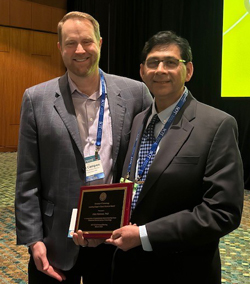 Dr. Rahman holds a PhD in biochemistry on neutrophil functions in hypertension. He completed a postdoctoral fellowship on lung toxicology at the University of Miami and Georgetown University before relocating to the University of Edinburgh, where he focused on environmental agents and lung inflammation and received an appointment as a Senior Research Scientist/Lecturer. In 2003, Dr. Rahman joined the faculty of the University of Rochester Medical Center Department of Environmental Medicine where he has risen through the faculty ranks with appointments with the Department of Public Health Sciences, Division of Pulmonary and Critical Care Medicine, and Eastman Institute for Oral Health. Since 2018, he has been the Director of the Center for Inhalation and Flavoring Toxicological Research.
Dr. Rahman holds a PhD in biochemistry on neutrophil functions in hypertension. He completed a postdoctoral fellowship on lung toxicology at the University of Miami and Georgetown University before relocating to the University of Edinburgh, where he focused on environmental agents and lung inflammation and received an appointment as a Senior Research Scientist/Lecturer. In 2003, Dr. Rahman joined the faculty of the University of Rochester Medical Center Department of Environmental Medicine where he has risen through the faculty ranks with appointments with the Department of Public Health Sciences, Division of Pulmonary and Critical Care Medicine, and Eastman Institute for Oral Health. Since 2018, he has been the Director of the Center for Inhalation and Flavoring Toxicological Research.
The research program that Dr. Rahman has developed unites the fields of circadian biology, chromatin remodeling, inflammation, sirtuin1 deacetylase (SIRT1) dynamics, and oxidants related to the impact of tobacco products on lung toxicology. He has been a longstanding pioneer with seminal contributions and cutting-edge research on mitophagy, steroid resistance, and lung cellular senescence and is a leader in the role of oxidative stress and redox signaling in gene transcription in tobacco-related pulmonary diseases. In addition, he also has been a leader in the molecular biology of chromatin remodeling and cellular senescence in the lung in response to oxidative stress and cigarette smoke and was the first to show chromatin remodeling and cellular senescence in the lung in response to cigarette smoke. He has identified several exciting potential therapies that could prevent tobacco-related lung complications from progressing.
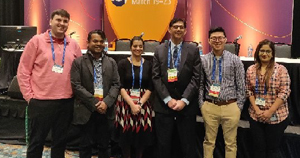 Dr. Rahman’s mechanistic discoveries and experience translated rapidly to address major issues for human health in the past five years, namely COVID-19 and e-cigarette toxicity. Of critical importance, he is constantly evolving his research to meet the challenging landscape of tobacco/e-cigarette products for lung health. For example, with regard to the rapid emergence of e-cigarettes in the high school population and the hookah waterpipe tobacco bars in college communities, Dr. Rahman already has published several papers on these products. During the pandemic, Dr. Rahman worked on COVID-19 biospecimens and showed that smokers/vapers are more susceptible to infection and are more likely to develop strong lung inflammatory response via upregulation of ACE2 via nicotine receptor alpha 7, particularly in older individuals.
Dr. Rahman’s mechanistic discoveries and experience translated rapidly to address major issues for human health in the past five years, namely COVID-19 and e-cigarette toxicity. Of critical importance, he is constantly evolving his research to meet the challenging landscape of tobacco/e-cigarette products for lung health. For example, with regard to the rapid emergence of e-cigarettes in the high school population and the hookah waterpipe tobacco bars in college communities, Dr. Rahman already has published several papers on these products. During the pandemic, Dr. Rahman worked on COVID-19 biospecimens and showed that smokers/vapers are more susceptible to infection and are more likely to develop strong lung inflammatory response via upregulation of ACE2 via nicotine receptor alpha 7, particularly in older individuals.
Dr. Rahman’s publications list consists of 225 original papers, 90 reviews, and 25 book chapters with an h-index of 110 with more than 50,000 citations; he also was selected for a list of Highly Cited Researchers by Thomson Reuters in 2014, 2015, and 2016. He has been recognized internationally and is ranked 16 of 52,718 active respiratory and allergy researchers by Ioannidis et al. (2020) He is the editor and author of Inflammation, Aging, Diet, and Nutrition, a book published by Elsevier in 2013. During his career, he has held 21 Associate Editor and Editorial Board memberships and has reviewed articles for more than 50 journals. In addition, he is the Principal Investigator on four National Institutes of Health grants.
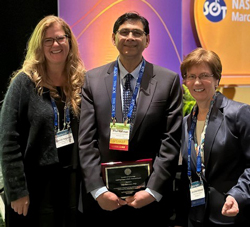 Dr. Rahman has devoted his career to teaching, understanding, and the prevention/treatment of smoking-related lung diseases. Over the years Dr. Rahman has mentored eight full-time graduate students, 30 postdoctoral scholars, and four undergraduate students, several of whom are now prominent faculty members at various institutions.
Dr. Rahman has devoted his career to teaching, understanding, and the prevention/treatment of smoking-related lung diseases. Over the years Dr. Rahman has mentored eight full-time graduate students, 30 postdoctoral scholars, and four undergraduate students, several of whom are now prominent faculty members at various institutions.
Dr. Rahman has attended the SOT Annual Meeting and ToxExpo regularly since 2003 and has been an SOT member since 2005. He has continuously provided leadership in SOT, serving as a Councilor and President of the SOT Inhalation and Respiratory Specialty Section. He also has been involved in the American Thoracic Society as a Program Committee member for the Respiratory Cell and Molecular Biology (RCMB) Assembly and created the Lung Aging Research Interest Group in the RCMB Assembly. In 2022, he received an American Thoracic Society Recognition Award for Scientific Accomplishments.
#Communique:SOTNews
#Awards
#Members
Read More: The 2023 SOT Leading Edge in Basic Science Award Recognizes Irfan Rahman for His Contributions to Pulmonary Toxicology and Specifically How E-Cig and Cigarette Smoke Causes Lung Injury and DiseasePFAS: What You Need to Know
Tuesday, March 21, 2023
 PFAS are potentially harmful chemicals that can be found in common, everyday products and most drinking water. They are known as “forever chemicals” because they do not break down over time, and health leaders across the country are concerned about the negative effects of long-term exposure.
PFAS are potentially harmful chemicals that can be found in common, everyday products and most drinking water. They are known as “forever chemicals” because they do not break down over time, and health leaders across the country are concerned about the negative effects of long-term exposure.
Researchers at URMC study the impacts PFAS have on our health. Scientists Martha Susiarjo, PhD, associate professor of Environmental Medicine, and Jing (Jason) Wu, PhD, assistant professor of Medicine and Pharmacology/Physiology share what they know about the chemicals and how they impact our lives.
Read More: PFAS: What You Need to KnowNight-shift workers are more vulnerable to permanent lung damage
Tuesday, March 14, 2023
A recent study by Dr. Irfan Rahman’s lab at the Department of Environmental Medicine, URMC, first authored by Qixin Wang, PhD published on March 2023 on https://doi.org/10.1038/s41467-023-36896-0 or https://www.nature.com/articles/s41467-023-36896-0.pdf, entitled Circadian clock molecule Rev-erbα regulates lung fibrotic progression through collagen stabilization by Qixin Wang, Isaac Kirubakaran Sundar, Joseph H. Lucas, Jun-Gyu Park, Aitor Nogales, Luis Martinez-Sobrido, Irfan Rahman. This study highlighted that circadian exposures to virus and chemicals cause profound lung fibrosis.
Lung fibrosis/cancer is a devastating disease that affects millions of people worldwide, yet we still lack effective treatments. A new study by researchers at the University of Rochester Medical Center has identified a potential therapeutic target for lung fibrosis by looking at how your circadian rhythm affects the severity and progression of this deadly disease. The study, published recently in Nature Communications, shows that a circadian clock molecule called REV-ERBα regulates the progression of lung fibrosis by stabilizing collagen, a major component during tissue scarring. The authors also show that the abundance of REV-ERBα varies over the day and may indicate that people may be more susceptible to pulmonary fibrosis during the night time. The findings have potential implications for the development of treatments for lung fibrosis, a chronic and often fatal disease that affects millions of people worldwide. This may also have implications in lung fibrosis which occurs in lung cancer patients.
This study showed that REV-ERBα was decreased during fibrotic progression, and interacts with lysyl oxidase, an enzyme responsible for regulating collagen stabilization and degradation. Mice lacking REV-ERBα showed more vulnerability and more fibrogenesis tendency when infected with influenza A virus or bleomycin (a chemotherapeutic drug). More profoundly, the lung injury that occurred during the night presented with worse fibrosis. Activating REV-ERBα with pharmaceutical drugs (SR9009 and GSK4112) could effectively reduce the abundance of collagens and lysyl oxidases, as well as fibrogenesis and myofibroblast differentiation, critical cellular mechanisms involved in pulmonary fibrosis.
“These findings highlight the importance of understanding the complex interactions between circadian rhythms and fibrotic disease. We hope that this research will lead to new treatments that can improve the lives of those suffering from lung fibrosis." Lead author Irfan Rahman, Ph.D., noted the importance of understanding the molecular mechanisms underlying lung fibrosis and environmental hazards associated with fibrotic lung disease “ Night-shift workers on construction utilizing asbestos or other carcinogenesis materials should pay extra attention to protect themselves from inhaling hazardous materials, which could cause greater injury the lungs.” Lung cancer patients have fibrosis due to accumulation of collagen and/or chemotherapy and radiation. Treatment of these patients will also be beneficial given by this circadian clock molecule agonist.
Overall, this study highlights the potential for targeting circadian clock molecules like REV-ERBα to improve outcomes for patients with lung fibrosis. Further research is needed to determine the therapeutic potential of other REV-ERBα agonists and other circadian clock molecules in the treatment of this often fatal disease including lung cancer.
EHSC Pilot Funds Available
Tuesday, March 7, 2023
The Environmental Health Sciences Center (EHSC) has funds to support meritorious Pilot Projects for research that seek to understand how environmental factors influence health and disease. Proposals that include basic science, translational, computational, and clinical research on the modulation of human health by environmental exposures or agents, including climate change, are welcome. Research projects using model organisms, human subjects approaches and data, exposure data or other types of data are welcome. We are especially interested in receiving proposals that investigate developmental origins of disease at any subsequent stage of the life cycle, genetic and environmental factors and/or their interactions that modulate susceptibilities, as well as interventions for mitigating the deleterious effects of environmental factors on human health. Utilization of the unique EHSC Facility Cores and/or interaction with our Community Engagement Core are encouraged. Applicants may request a maximum of $30,000 for the duration of one year and must hold a tenure-track faculty position. New investigators collaborating with existing EHSC members are encouraged to apply. Funds are restricted to research expenses and staff salaries. Salary of biostatisticians or research faculty will be considered with appropriate justification.
This is a two-stage process. Initial applications should include a one-page abstract describing the goals and objectives of the proposed project, the investigators involved, and the relevance of the proposal to the mission of the EHSC (https://www.urmc.rochester.edu/environmental-health-sciences.aspx). There is no form template for this one-page abstract. All abstracts will be reviewed by the EHSC Pilot Project Steering Committee. Applicants will be notified as promptly as possible if their abstract has been selected for a full submission.
The deadline for submitting initial applications is April 7, 2023
Interested applicants are encouraged to contact us for more information or relevance of their proposal. Contact Martha Susiarjo or Pat Noonan-Sullivan. Visit the EHSC website for full details.
Please submit your abstracts to Pat Noonan-Sullivan via email.
Iron & the brain: Where and when neurodevelopmental disabilities may begin during pregnancy
Monday, March 6, 2023
Study finds possible cellular origin for impairments associated with gestational iron deficiency
The cells that make up the human brain begin developing long before the physical shape of the brain has formed. This early organizing of a network of cells plays a major role in brain health throughout the course of a lifetime. Numerous studies have found that mothers with low iron levels during pregnancy have a higher risk of giving birth to a child that develops cognitive impairments like autism, attention deficit syndrome, and learning disabilities. However, iron deficiency is still prevalent in pregnant mothers and young children.
The mechanisms by which gestational iron deficiency (GID) contributes to cognitive impairment are not fully understood. The laboratory of Margot Mayer- Proschel, PhD, a professor of Biomedical Genetics and Neuroscience at the University of Rochester Medical Center, was the first to demonstrated that the brains of animals born to iron-deficient mice react abnormally to excitatory brain stimuli, and that iron supplements giving at birth does not restore functional impairment that appears later in life. Most recently, her lab has made a significant progress in the quest to find the cellular origin of the impairment and have identified a new embryonic neuronal progenitor cell target for GID. This study was recently published in the journal Development.
“We are very excited by this finding,” Mayer-Proschel said, who was awarded a $2 million grant from the National Institute of Child Health & Human Development in 2018 to do this work. “This could connect gestational iron deficiency to these very complex disorders. Understanding that connection could lead to changes to healthcare recommendations and potential targets for future therapies.”
Read More: Iron & the brain: Where and when neurodevelopmental disabilities may begin during pregnancyDr. Irfan Rahman interview with Forbes Magazine
Wednesday, February 22, 2023
 While the prevalence of cigarette smoking declined significantly in the past two decades, vaping is on the rise. An estimated 5.66 million adults in the U.S. vape, according to a 2020 JAMA Network scientific paper[1]. Perhaps most alarming, over 2.5 million high school and middle school students vape, reports the 2022 National Youth Tobacco Survey from the Food and Drug Administration (FDA) and Centers for Disease Control and Prevention (CDC)[2].
While the prevalence of cigarette smoking declined significantly in the past two decades, vaping is on the rise. An estimated 5.66 million adults in the U.S. vape, according to a 2020 JAMA Network scientific paper[1]. Perhaps most alarming, over 2.5 million high school and middle school students vape, reports the 2022 National Youth Tobacco Survey from the Food and Drug Administration (FDA) and Centers for Disease Control and Prevention (CDC)[2].
The dangers of e-cigarettes are well documented, but the effects of vaping cannabidiol (CBD) aren’t common knowledge. CBD is often heralded in the wellness space as a natural way to help alleviate symptoms of anxiety and depression, relieve pain and improve sleep. However, these potential benefits can lead to confusion surrounding the health and safety of vaping the cannabinoid. Below, experts explain the science behind how vaping CBD affects the body and whether it’s a habit to engage in or avoid.
Read More: Dr. Irfan Rahman interview with Forbes MagazineResearchers look for link between air pollution and brain disease
Tuesday, January 17, 2023
Deborah Cory-Slechta, a professor of environmental medicine, of public health sciences, and of neuroscience, discusses findings from researchers trying to figure out how much, and to what extent, airborne contaminants are linked to neurodegenerative diseases like Alzheimer’s and Parkinson’s.
University Launches Institute for Human Health and the Environment to Find Solutions to the 21st Century’s Most Pressing Health Issues
Friday, January 13, 2023
The foods we consume. The air we breathe. The stress we experience. The chemicals we are exposed to (willingly and unwillingly). The changing climate. Everything in and around us influences our health. Amazingly, quality of life and longevity are more closely tied to where someone lives than their genetic code.
The University of Rochester believes that finding solutions to the 21st Century’s most pressing health issues – including cancer, heart disease, neurodegenerative disorders, and our ability to fight infection – requires a collaborative commitment to research, education, and community engagement related to how the environment influences health across the lifespan. The new UR Institute for Human Health and the Environment (IHHE) will bring this vision to life.
Led by B. Paige Lawrence, Ph.D., the Institute will serve as a local and national hub to catalyze new scientific discoveries related to environmental impacts on health and transform this information into actions that will promote healthier lives for all.
“The University has been a leader in research and education in environmental health and toxicology since the 1940s, so we’re building off an extremely strong foundation,” said Lawrence, the Wright Family Research Professor and chair of the department of Environmental Medicine. “Many teams are already conducting research, teaching, and working with community members on issues related to the environment and health, but we know we can do more. It is exciting to launch this new institute, and I encourage folks to get involved. We want to hear what people across the University are passionate about and help to make their work more impactful. I encourage anyone who is interested to check out our web site and reach out to us – we want to hear from you!”
“Environmental factors such as geographic location and exposure to toxins have a profound impact on susceptibility to disease,” said Mark B. Taubman, M.D., URMC CEO and dean of the School of Medicine and Dentistry. “Some populations are disproportionately affected by these environmental risks, particularly communities of color. Collectively, we have the experience needed to partner with these communities and to use our knowledge to modify or prevent risk factors and make a difference in their lives.”
The IHHE will integrate programs and expertise from across all UR schools and will be anchored by three interactive pillars: Research; Career Development and Education; and Engagement. Initially, the Institute’s key areas of focus will include climate change and health; environmental justice; how water and air pollution impact health; and how environmental factors shape health across our whole lifetime.
Research
The IHHE will serve as a major hub for innovative and inclusive research that melds academic and scholarly disciplines. By creating new opportunities to gather knowledge and bring together different points of view, and through the sharing of expertise, the IHHE will propel research on many facets of environmental health. Gaining a better understanding of the intrinsic molecular, cellular, and socioeconomic mechanisms that underpin associations between health and the environment will transform care and lead to new ways to improve public health.
Career Development and Education
The Institute will support education and career development across all career stages. It will enhance existing programs, including an undergraduate major in Environmental Health, and multiple graduate programs, including Toxicology, Epidemiology, and Biostatistics & Computational Biology. Understanding how environmental factors influence health is already part of several other programs anchored in Public Health Sciences, Neuroscience, Engineering, and Data Science. The Institute will strengthen and extend connections between these programs and support a more diverse and inclusive environment to recruit and retain highly talented individuals. The Institute will also support programs for K-12 students in the Rochester area.
Engagement
The IHHE builds on a long history of environmental justice and community engagement related to how the lived environment influences the health of individuals and communities. This includes working with local community members to develop, evaluate, and disseminate community-based approaches to solve problems. For example, teams at UR contributed to Rochester’s local lead poisoning prevention system, which has resulted in lead poisoning rates declining 2.4 times faster than elsewhere in NY State, and has served as a national model for community-based action. Activities will be anchored in multidirectional engagement between the University and local and global partners to shape research and to evaluate and inform changes in policies, systems, and communities.
Anyone who is interested in learning more about the Institute and how they can get involved can visit the IHHE web site or reach out to the leadership team: